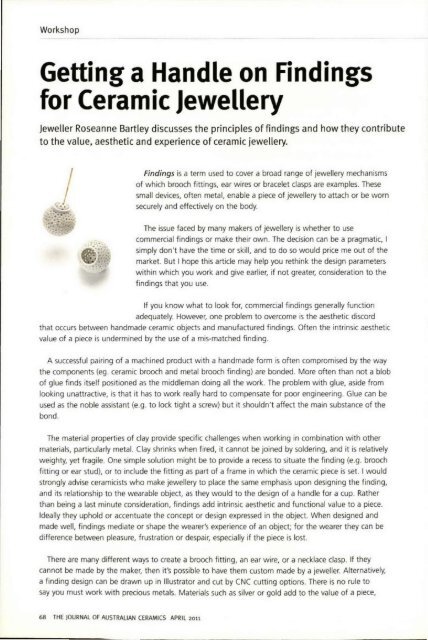The Journal of Australian Ceramics Vol 50 no 1 April 2011
You also want an ePaper? Increase the reach of your titles
YUMPU automatically turns print PDFs into web optimized ePapers that Google loves.
Workshop<br />
Getting a Handle on Findings<br />
for Ceramic Jewellery<br />
Jeweller Roseanne Bartley discusses the principles <strong>of</strong> findings and how they contribute<br />
to the va lue, aesthetic and experience <strong>of</strong> ceramic jewellery.<br />
j<br />
Findings is a term used to cover a broad range <strong>of</strong> jewellery mechanisms<br />
<strong>of</strong> which brooch fittings. ear wires or bracelet clasps are examples. <strong>The</strong>se<br />
small devices. <strong>of</strong>ten metal, enable a piece <strong>of</strong> jewellery to attach or be worn<br />
securely and effectively on the body.<br />
<strong>The</strong> issue faced by many makers <strong>of</strong> jewellery is whether to use<br />
commercial findings or make their own. <strong>The</strong> decision can be a pragmatic, I<br />
simply don't have the time or skill. and to do so would price me out <strong>of</strong> the<br />
market. But I hope this article may help you rethink the design parameters<br />
within which you work and give earlier, if <strong>no</strong>t greater, consideration to the<br />
findings that you use.<br />
If you k<strong>no</strong>w what to look for, commercial findings generally function<br />
adequately. However, one problem to overcome is the aesthetic discord<br />
that occurs between handmade ceramic objects and manufactured findings. Often the intrinsic aesthetic<br />
value <strong>of</strong> a piece is undermined by the use <strong>of</strong> a mis-matched finding.<br />
A successful pairing <strong>of</strong> a machined product with a handmade form is <strong>of</strong>ten compromised by the way<br />
the components (eg. ceramic brooch and metal brooch finding) are bonded. More <strong>of</strong>ten than <strong>no</strong>t a blob<br />
<strong>of</strong> glue finds itself positioned as the middleman doing all the work. <strong>The</strong> problem with glue. aside from<br />
looking unattractive, is that it has to work really hard to compensate for poor engineering. Glue can be<br />
used as the <strong>no</strong>ble assistant (e.g. to lock tight a screw) but it shouldn't affect the main substance <strong>of</strong> the<br />
bond.<br />
<strong>The</strong> material properties <strong>of</strong> clay provide specific challenges when working in combination w ith other<br />
materials. particularly metal. Clay shrinks when fired, it can<strong>no</strong>t be joined by soldering, and it is relatively<br />
weighty, yet fragile. One simple solution might be to provide a recess to situate the finding (e.g. brooch<br />
fitting or ear stud), or to include the fitting as part <strong>of</strong> a frame in which the ceramic piece is set. I would<br />
strongly advise ceramicists who make jewellery to place the same emphasis upon designing the finding,<br />
and its relationship to the wearable object, as they would to the design <strong>of</strong> a handle for a cup . Rather<br />
than being a last minute consideration, findings add intrinsic aesthetic and functional value to a piece.<br />
Ideally they uphold or accentuate the concept or design expressed in the object. When designed and<br />
made well, findings mediate or shape the wearer's experience <strong>of</strong> an object; for the wearer they can be<br />
difference between pleasure, frustration or despair, especially if the piece is lost.<br />
<strong>The</strong>re are many different ways to create a brooch fitting, an ear wire, or a necklace clasp. If they<br />
can<strong>no</strong>t be made by the maker, then it's possible to have them custom made by a jeweller. Alternatively,<br />
a finding design can be drawn up in Illustrator and cut by CNC cutting options. <strong>The</strong>re is <strong>no</strong> rule to<br />
say you must work with precious metals. Materials such as silver or gold add to the value <strong>of</strong> a piece,<br />
68 THE JOURNAL OF AUSTRALIAN CERAMICS APRil <strong>2011</strong>

















